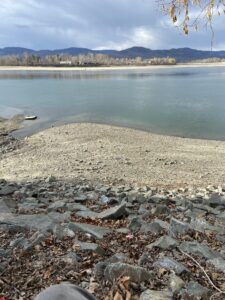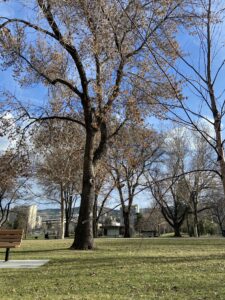My location of choice is in Riverside Park, on the south side of the Thompson River in Kamloops, BC. GPS coordinates are 50.6784°N, 120.3369°W. Starting from the river, which has a narrow sandbank in the middle, there is 5 meters of pebbly, rocky beach, which leads to a steep rocky incline of about 4 meters. The difference in elevation is around 3 meters. From the top of this climb, there is a grassy lawn interspersed with many trees and some paved pathways, about 50 meters out from the rocks. This location is about 200 meters away from the most popular portion of the beach in this park.
I first observed on March 25 starting at 4:58pm. It was a balmy, slightly overcast day, with about 75% cloud cover and a temperature of 9℃. I observed many Mallard ducks (Anas platyrhynchos), mostly in the water, although a couple seemed to be napping on land, and Canada geese (Branta canadensis), mainly strolling on land or flying. There were also seagulls flying around and landing on the sandbar in the river. I also spotted a spider and two flying insects. There were various tree species planted within the park, some of which appeared to be putting out their first new buds, and some which still had old leaves attached.
Some potential research questions:
- What are the behavioural differences between ducks and geese? (Where they spend time, with how many individuals, etc.)
- Does the number of beachgoers effect the ducks’ numbers/movements?
- Will different tree species begin budding at different times?
- Does the time of day effect the size of the sandbar in the river, and consequently the number of seagulls there?
- Will there be an increase in flying insects depending on the weather (or as the season progresses)?


Image 1 (left). The stony incline leading to the pebbly beach.
Image 2 (right). The grassy lawn with many trees.